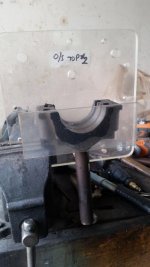busybrit
Jedi Hopeful
Offline
I'm in the process of re-building a 3000 engine, and having read somewhere on this forum that the removal of the drain tube from the rear main cap would increase the flow of oil in the area of the rear scroll or after market rear seal, thus reducing the oil loss through the rear seal.
Well not being too sure if this was correct I set up the rear mains cap in the vice, glued between two scrap pieces of plastic. I then pored 5 qts of 20/50 through the cap and timed it. 3 minutes 33 seconds. Did the same with the drain tube removed, 3 minutes and 23 seconds.
If the removal of the drain tube does actually increase the flow, I suggest that when fitted the oil level in the oil pan is more likely restricting the flow leaving the drain tube. May be,, just shortening the tube so the oil exits above the oil level in the oil pan would do the trick?

Any thoughts ?
Well not being too sure if this was correct I set up the rear mains cap in the vice, glued between two scrap pieces of plastic. I then pored 5 qts of 20/50 through the cap and timed it. 3 minutes 33 seconds. Did the same with the drain tube removed, 3 minutes and 23 seconds.
If the removal of the drain tube does actually increase the flow, I suggest that when fitted the oil level in the oil pan is more likely restricting the flow leaving the drain tube. May be,, just shortening the tube so the oil exits above the oil level in the oil pan would do the trick?
Any thoughts ?

 Hi Guest!
Hi Guest!

 smilie in place of the real @
smilie in place of the real @
 Pretty Please - add it to our Events forum(s) and add to the calendar! >>
Pretty Please - add it to our Events forum(s) and add to the calendar! >> 
